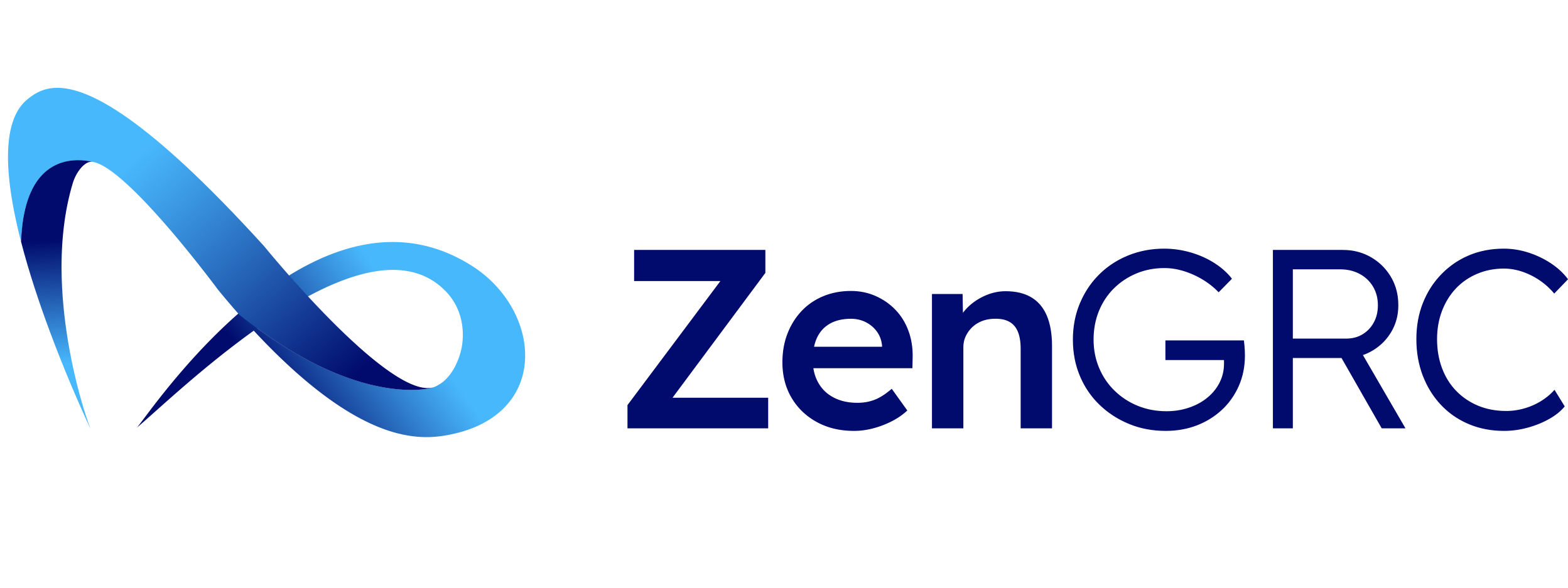Tired of drowning in GDPR documentation and manual compliance processes? Stop struggling with spreadsheets, disconnected systems, and the constant fear of missing critical requirements that could lead to devastating penalties. ZenGRC transforms your GDPR compliance from a resource-draining burden into a streamlined, automated program that protects your organization while freeing your team to focus on strategic initiatives. Book a demo with ZenGRC today and discover how automation can help you achieve GDPR compliance.

In May of 2023, Meta was hit with a record-breaking GDPR fine of €1.2 billion for violating laws on digital privacy and putting the data of EU citizens at risk through Facebook’s EU-U.S. data transfers. The General Data Protection Regulation (GDPR) is a European Union (EU) law that governs how organizations within and outside the EU handle the personal data of EU residents, establishing rights for individuals and outlining obligations for organizations regarding data collection, use, and protection.
This massive fine serves as a stark reminder that GDPR compliance isn’t optional—it’s essential for any organization that processes EU citizens’ data, regardless of where the company is based. Since its implementation in 2018, GDPR enforcement has only intensified, with regulatory authorities increasingly willing to impose substantial penalties for violations.
For GRC professionals, the challenges of maintaining GDPR compliance are complex. Many organizations still rely on manual processes—spreadsheets, email threads, and disconnected documentation—to track compliance efforts. This approach is not only time-consuming and resource-intensive but also prone to errors and gaps that can lead to costly violations.
The financial implications of non-compliance extend far beyond the headline-grabbing fines like Meta’s. Companies can face penalties of up to €20 million or 4% of annual global turnover, whichever is higher. Add to this the reputational damage, lost business opportunities, and potential legal actions from affected individuals, the true cost of non-compliance becomes even more significant.
In this article, we’ll examine the key challenges of GDPR compliance, provide an essential compliance checklist, and explore how ZenGRC’s automation capabilities can help your organization build and maintain an effective data privacy program while avoiding costly penalties.
Key GDPR Compliance Challenges for Organizations
Meeting GDPR requirements presents significant challenges that can strain resources and create compliance gaps when managed through manual processes. Understanding these challenges is the first step toward implementing effective solutions.
The Documentation Burden
GDPR compliance demands extensive documentation across your entire data ecosystem. For example, Article 30 mandates maintaining detailed records of processing activities (ROPAs), while Article 35 requires Data Protection Impact Assessments (DPIAs) for high-risk processing. Privacy teams must also create and maintain documentation for consent mechanisms, data subject request procedures, and breach response protocols.
The manual effort required to maintain this documentation is substantial. Teams often spend hours each week updating spreadsheets, cross-referencing information, and ensuring documentation remains accurate. This administrative burden diverts resources from strategic privacy initiatives and increases the risk of documentation gaps that could lead to compliance failures during regulatory investigations.
Managing the Complex Web of Requirements
GDPR’s 99 articles and 173 recitals create a complex web of requirements that organizations must navigate. The regulation is principle-based rather than prescriptive, leaving room for interpretation that creates additional compliance uncertainty.
Further complicating matters is that GDPR implementation continues to evolve. New regulatory guidance, court rulings, and different interpretations from EU member states’ data protection authorities can quickly change compliance requirements. This shifting landscape means organizations must constantly adapt their privacy programs to stay compliant.
Resource Constraints and Manual Process Inefficiencies
Privacy compliance often falls to already-overloaded teams wearing multiple hats. Few companies have dedicated privacy specialists, leading to fragmented responsibility where IT handles security aspects, legal manages contracts, and marketing oversees consent—all without a unified approach. This disjointed implementation creates blind spots that regulators increasingly target.
Manual compliance processes—typically involving things like spreadsheets and email communications—create significant inefficiencies:
- Organizational challenges for policy documents
- Inconsistent evidence collection
- Difficulty tracking completion status of compliance tasks
- Challenges in demonstrating accountability to regulators
- Inability to provide real-time compliance status to leadership
Third-Party Risk Management Complications
Perhaps the most complex GDPR challenge involves third-party risk management. Organizations (as data controllers) remain liable for GDPR violations by their service providers (data processors). Data breaches frequently involve third-party access, making this a critical vulnerability.
Managing these risks requires:
- Vetting vendors prior to engagement
- Implementing appropriate contractual safeguards
- Conducting ongoing compliance monitoring
- Ensuring appropriate data transfer mechanisms are in place
- Documenting all aspects of the controller-processor relationship
When these activities are managed manually across dozens or even hundreds of vendors, the likelihood of compliance gaps increases substantially.
The combination of these challenges creates significant risk exposure for organizations still relying on manual GDPR compliance processes. In the next section, we’ll outline the essential components of a GDPR compliance program.
Essential GDPR Compliance Checklist for Today’s Organizations
As data protection authorities step up enforcement and penalties grow larger, organizations must develop robust GDPR practices. This practical checklist outlines the requirements for building an effective compliance program.
Data Mapping and Inventory
The foundation of GDPR compliance lies in understanding your data ecosystem:
- Document all personal data processing activities
- Identify all data storage locations (cloud services, servers, third-parties)
- Classify data by sensitivity
- Map data flows across your organization
- Document retention periods and deletion procedures
Manual inventory management typically results in outdated information that fails to capture new processing activities.
Lawful Basis and Processing Documentation
GDPR requires a documented lawful basis for all processing:
- Determine and document the appropriate legal basis for each activity
- Implement mechanisms to obtain and record valid consent
- Establish processes for handling consent withdrawal
- Document legitimate interest assessments where applicable
- Maintain records of processing activities (ROPAs)
Many organizations struggle to maintain clear documentation connecting activities to their lawful basis, creating compliance gaps.
Data Subject Rights Fulfillment
Efficient request handling processes are essential:
- Create procedures for identity verification
- Develop response templates for each request type
- Implement tracking systems for request deadlines
- Document all responses and outcomes
- Establish mechanisms to fulfill requests across multiple systems
Manual request management often leads to missed deadlines and incomplete responses that can trigger penalties.
Security and Breach Management
GDPR requires appropriate technical and organizational measures:
- Implement risk-appropriate security controls
- Document security measures and rationale
- Establish breach detection mechanisms
- Develop and test response procedures
- Create notification templates for authorities and affected individuals
Organizations without systematic breach management processes struggle to meet the 72-hour notification requirement.
Third-Party Processor Management
Effective vendor management is critical:
- Create standardized assessment questionnaires
- Implement compliant data processing agreements
- Maintain records of international transfer mechanisms
- Conduct regular audits of key processors
- Document processor security commitments
The distributed nature of vendor management makes this one of the most challenging aspects to track manually.
Accountability and Governance Documentation
GDPR’s accountability principle requires demonstrable compliance:
- Maintain current privacy policies and notices
- Document data protection by design processes
- Record staff training programs
- Maintain DPO appointment documentation
- Document periodic compliance reviews
Without centralized management, these records become fragmented and difficult to compile when needed to prove compliance.
Most organizations understand these requirements but struggle to implement and maintain them efficiently across complex operations. The next section explores how ZenGRC addresses these challenges through automation and centralization.
How ZenGRC Automates Your GDPR Compliance Program and Maximizes ROI
ZenGRC makes GDPR compliance easy through automation, pre-built templates, and real-time monitoring. The platform not only transforms manual processes into efficient workflows but also delivers measurable return on investment beyond penalty avoidance.
Pre-built Templates and Frameworks with Immediate Value
ZenGRC eliminates building your GDPR program from scratch:
- Ready-to-use GDPR control frameworks aligned with current regulatory requirements
- Pre-configured evidence request templates for efficient documentation collection
- Standardized assessment questionnaires for internal and third-party evaluations
- Documentation templates for required GDPR processes and procedures
These resources enable faster implementation and ensure comprehensive coverage, reducing both compliance gaps and the time to value for your compliance investment.
Centralized Documentation Repository for Risk Reduction
ZenGRC consolidates all GDPR documentation in a central, secure location:
- Store policies, procedures, and evidence in a single searchable repository
- Maintain version control with complete audit history
- Link evidence directly to specific GDPR requirements
- Enable secure, role-based access to documentation across the organization
This centralization eliminates fragmentation of compliance evidence, significantly reducing the risk of costly penalties by ensuring you can quickly demonstrate compliance during regulatory inquiries.
Automated Workflows for Resource Optimization
ZenGRC automates time-consuming compliance processes:
- Configure automated evidence collection workflows with clear ownership
- Send automated reminders for overdue tasks
- Track evidence collection status in real-time
- Schedule recurring evidence collection for requirements needing regular updates
These automations cut administrative overhead by up to 70%, redirecting resources from manual documentation to strategic privacy initiatives that deliver greater business value.
Real-Time Monitoring for Proactive Compliance Management
ZenGRC monitors your entire compliance lifecycle with clear visibility:
- User-friendly dashboards with real-time metrics on prioritized GDPR tasks
- Tracking of outstanding tasks and required documentation
- Real-time alerts for approaching deadlines or compliance gaps
- Customizable reports for different stakeholders
This visibility ensures you identify and address problems proactively rather than discovering issues during an investigation or after a breach, representing significant ROI compared to reactive compliance management.
Enhanced Adaptability for Regulatory Changes
The GDPR landscape continues to evolve through new guidance, court decisions, and emerging best practices. ZenGRC helps you stay current:
- Regular platform updates incorporate new regulatory guidance
- Pre-built control frameworks reflect current interpretations
- Control mapping allows efficient implementation of new requirements
- Gap analysis tools quickly identify areas needing attention
This adaptability ensures your compliance program remains effective as regulations shift, protecting your investment over time.
Control Mapping for Multi-Regulatory Efficiency
For organizations complying with multiple privacy regulations, ZenGRC allows you to:
- Map controls across multiple frameworks (GDPR, CCPA/CPRA, ISO 27701)
- Identify control overlaps to streamline compliance efforts
- Implement single controls that satisfy multiple regulatory requirements
- Update mapped controls across frameworks when regulations change
This approach reduces duplication of effort and creates significant resource savings across your entire compliance program.
By transforming GDPR compliance from a manual burden to an automated, efficient process, ZenGRC delivers both immediate operational benefits and long-term strategic value, equipping your organization with comprehensive risk management functionality for the entire compliance lifecycle. For more detailed information on GDPR requirements and compliance strategies, check out our comprehensive GDPR resource page.
Conclusion
As regulatory scrutiny intensifies, effective GDPR compliance management has never been more critical. The challenges of maintaining compliance through manual processes have become increasingly more difficult for organizations of all sizes.
ZenGRC transforms GDPR compliance from a resource-intensive burden to a streamlined, efficient program that delivers measurable business value:
- Comprehensive Coverage: Pre-built frameworks ensure all GDPR requirements are addressed
- Operational Efficiency: Automation reduces the resource burden of compliance activities
- Enhanced Visibility: Real-time dashboards provide clear insights into compliance status
- Simplified Documentation: Centralized repository eliminates fragmentation and version control issues
- Adaptability: Flexible framework updates keep pace with evolving requirements
- Demonstrable Accountability: Structured evidence collection supports the accountability principle
By addressing the fundamental challenges of GDPR compliance, ZenGRC helps organizations not only avoid costly penalties but also build more efficient data protection programs.
Ready to transform your GDPR compliance program? See firsthand how ZenGRC can help your organization. Book a demo to see how ZenGRC can automate your GDPR compliance
